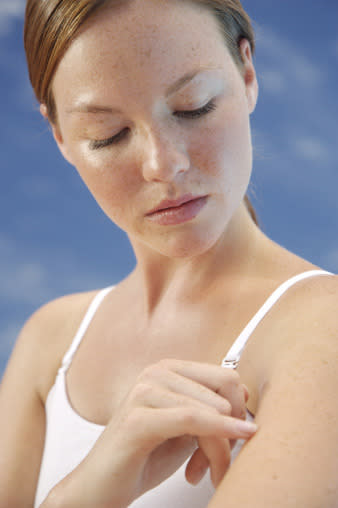Why Do People Get Freckles?

Sure, freckles are beautiful but we’ve always wondered why they crop up [Photo: Getty]
It’s one of those questions we’ve always wondered about our skin but never really known the answer to. Are freckles hereditary? Can freckles be dangerous? Why the heck do we have them?
Most of us with freckles will remember just always having freckles, but did you know that no one is actually born with freckles?
Freckles appear usually during childhood and increase in line with sun exposure. With the summer sun starting to make a more regular appearance, we found out more about why we get freckles and how they’re related to our skin health.

Supermodel Gisele wears her freckles with pride [Photo: Getty]
What are freckles?
Freckles are slightly darker spots on your skin which come in a variety of sizes. Not to be mistaken with a mole, freckles are smooth and not raised from the skin.
They occur when skin cells group together and produce a clump of melanin- the pigment colour that’s in our skin. As a result, freckles can come in a variety of colours, ranging from red to dark brown.
Does everyone get freckles?
Not everyone develops freckles. Freckles tend to be more common amongst people with light eyes, red hair and pale skin because they have less melanin in the skin.
If your family have freckles, it’s likely that you’ll have freckles too. They’re not a purely hereditary trait but families will have similar skin types which mean that if your parents have freckles, you’re more likely to have them too.

Freckles can occur with any skin type at any age [Photo: Getty]
Do you get more freckles with age?
More freckles occur with sun exposure rather than the ageing of the skin. Do you notice that you get more freckles when you’ve been out for a day in the sun? Being out in the sun without SPF or protection triggers the melanin production process which can lead to more or darker freckles.
There’s more than one type of freckle
Yes, there are actually a few types of freckle but the two main types are ephelides and lentigines. What’s the difference? Ephelides are the more common of the two. They normally appear on fair-skinned children after sun exposure and mainly on the face, hands or arms. They become darker with more sun exposure but actually fade if kept out of the sun as they are replaced by new cells.
Lentigines on the other hand, do not fade in the winter months. They are also known as age spots or liver spots, lentigines are normally much larger than ephelides. Although this kind of freckle happens at any age, they are more likely to appear on more mature skin and darker skin that tans easily.
Are freckles dangerous to your health?
Freckles aren’t immediately dangerous but they can indicate that you’re spending too much time in the sun without protection. People who get freckles are usually more likely to get sunburnt. Experts recommend to use a daily sunscreen to protect your skin – not just from pigmentation but also from accelerated ageing and sun damage.

Experts recommend wearing daily SPF [Photo: Getty]
Can you get rid of freckles?
Beautiful celebrities like Gisele proudly wear their freckles but some people do opt to have them surgically removed. This involves a laser removal procedure to burn the freckles from your skin. It’s definitely not pain-free and not necessarily a quick fix either. It can take several treatments before you might see a difference and it does not prevent more freckles from appearing.
If you’re looking for something a little bit less serious, bleaching creams are a potential option. Lightening and anti-pigmentation creams are really popular in the Asian beauty markets. They work either by inhibiting melanin production in the skin or by gently exfoliating the surface to reduce discolouration.

To improve excess melanin production, try La Roche Posay Pigmentclar Serum £19.70. It contains a high amount of Niacinamide, a B vitamin and also phenethyl resorcinol, a ingredient which does have some research that proves it lightens dark spots.
If you want to slowly fade your freckles whlst improving your general complexion, try Nip & Fab Glycolic Fix Night Pads Extreme £14.95, a more potent version of the bestselling Glycolic Fix pads (Emily Ratajowkski is a big fan). The 5% glycolic acid helps to fade pigmentation on the face and removes dead skin cells for a more even and smooth face.

As with all anti-pigmentation and exfoliating products, make sure you’re using minimum SPF25 otherwise the sun exposure on fresh skin will trigger melanin production again and undo your hard work. We like the Eucerin Even Brighter Pigment Reducing Day Cream £18, which contains SPF30.
Are freckles a skin concern for you? Do you protect your skin as much as you should? Tweet us your thoughts @YahooStyleUK.
Do We Actually Need To Wear Suncream Every Single Day?
9 Skin Loving Foundations That Could Actually Be Good For Your Skin

